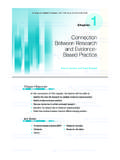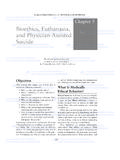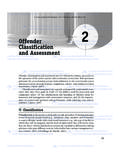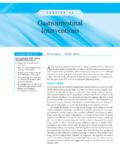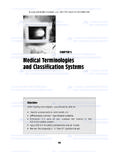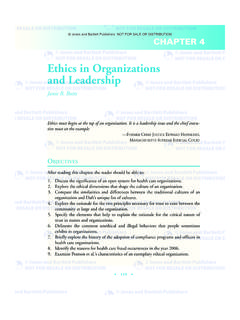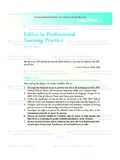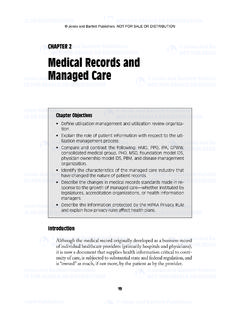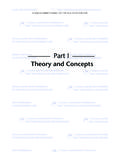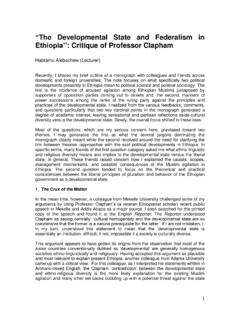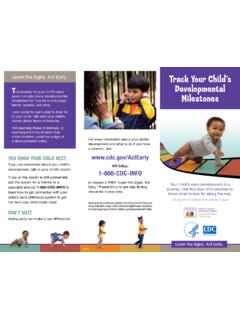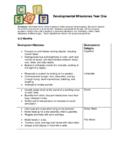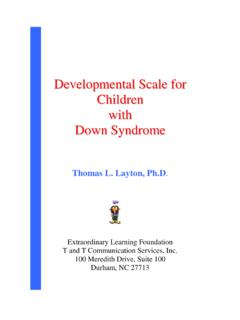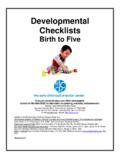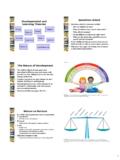Transcription of Chapter 5 Developmental Stages of the Learner Susan B ...
1 9/14/07 4:39 PM Page 1. Jones and Bartlett Publishers. NOT FOR SALE OR DISTRIBUTION. Chapter 5. Developmental Stages of the Learner Susan B. Bastable Michelle A. Dart Chapter HIGHLIGHTS. Developmental Characteristics The Developmental Stages of Adulthood The Developmental Stages of Childhood Young Adulthood (20 40 Years of Age). Infancy (First 12 Months of Life) and Middle-Aged Adulthood (41 64 Years Toddlerhood (1 2 Years of Age) of Age). Early Childhood (3 5 Years of Age) Older Adulthood (65 Years of Age and Middle and Late Childhood (6 11 Years Older). of Age) The Role of the Family in Patient Education Adolescence (12 19 Years of Age) State of the Evidence KEY TERMS. pedagogy personal fable object permanence andragogy causality dialectical thinking animistic thinking ageism syllogistical reasoning gerogogy conservation crystallized intelligence imaginary audience fluid intelligence 1.
2 9/14/07 4:39 PM Page 2. Jones and Bartlett Publishers. NOT FOR SALE OR DISTRIBUTION. 2 Chapter 5: Developmental Stages of the Learner OBJECTIVES. After completing this Chapter , the reader will be able to 1. Identify the physical, cognitive, and psychosocial characteristics of learners that influence learning at various Stages of growth and development. 2. Recognize the role of the nurse as educator in assessing stage -specific Learner needs according to maturational levels. 3. Determine the role of the family in patient education. 4. Discuss appropriate teaching strategies effective for learners at different Developmental Stages . When planning, designing, and implementing growth and development on an individual's will- an educational program, the nurse as educator ingness and ability to make use of instruction. must carefully consider the characteristics of This Chapter has specific implications for learners with respect to their Developmental staff nurses and staff development and in-service stage in life.
3 The more heterogeneous the target nurse educators because of the recent mandates audience, the more complex the development of by the Joint Commission (formerly known as an educational program to meet the diverse the JCAHO the Joint Commission on Ac- needs of the population. Conversely, the more creditation of Healthcare Organizations). For homogeneous the population of learners , the healthcare agencies to meet Joint Commission more straightforward the approach to teaching. accreditation requirements, teaching plans must An individual's Developmental stage signifi- address stage -specific competencies of the cantly influences the ability to learn. Pedagogy, Learner . In this Chapter , the distinct life Stages of andragogy, and gerogogy are three different ori- learners are examined from the perspective of entations to learning in childhood, young and physical, cognitive, and psychosocial develop- middle adulthood, and older adulthood, respec- ment; the role of the nurse in assessment of tively.
4 To meet the health-related educational stage -specific Learner needs; the role of the fam- needs of learners , a Developmental approach ily in the teaching learning process; and the must be used. Three major stage -range factors teaching strategies specific to meeting the needs associated with Learner readiness physical, of learners at various Developmental Stages of cognitive, and psychosocial maturation must life. be taken into account at each Developmental A deliberate attempt has been made to mini- period throughout the life cycle. mize reference to age as the criterion for catego- Developmental psychologists have for years rization of learners . Research on life-span explored the various patterns of behavior partic- development shows that chronological age per se ular to Stages of development. Educators, more is not the only predictor of learning ability than ever before, acknowledge the effects of (Santrock, 2006; Vander Zanden, Crandell, &.)
5 9/14/07 4:39 PM Page 3. Jones and Bartlett Publishers. NOT FOR SALE OR DISTRIBUTION. Developmental Characteristics 3. Crandell, 2007; Whitener, Cox, & Maglich, been uniquely exposed to similar histor- 1998). At any given age, one finds a wide varia- ical circumstances, such as the Vietnam tion in the acquisition of abilities related to the War, the age of computers, or the ter- three fundamental domains of development: rorist event of September 11, 2001. physical (biological), cognitive, and psychosocial 3. normative life events are the unusual or (emotional-social) maturation. Age ranges, unique circumstances, positive or nega- included after each Developmental stage heading tive, that are turning points in someone's in this Chapter , are intended only to be used as life that cause them to change direction, approximate age-strata reference points or gen- such as a house fire, serious injury in an eral guidelines; they do not imply that chrono- accident, winning the lottery, divorce, or logical ages necessarily correspond perfectly to an unexpected career opportunity.
6 The various Stages of development. Thus, the Although this Chapter focuses on the patient term Developmental stage will be the perspective as the Learner throughout the life span, the used based on the confirmation by psychologists stage -specific characteristics of adulthood and that human growth and development are the associated principles of adult learning pre- sequential but not always specifically age related. sented herein can be applied to any audience of Recently it has become clear that develop- young, middle, or older adult learners , whether ment is contextual. Even though the passage of the nurse is instructing the general public in the time has traditionally been synonymous with community, preparing students in a nursing chronological age, social and behavioral psy- education program, or teaching continuing edu- chologists have begun to consider the many cation to staff nurses.
7 Other changes occurring over time that affect on the dynamic relationship between a human being's biological make up and the environment. Developmental It is now understood that three important con- Characteristics textual influences act on and interact with the individual to produce development (Santrock, As noted, actual chronological age is only a rela- 2006; Vander Zanden et al., 2007): tive indicator of someone's physical, cognitive, and psychosocial stage of development. Unique 1. normative age-graded influences are as each individual is, however, some typical devel- strongly related to chronological age opmental trends have been identified as mile- and are similar for individuals in a par- stones of normal progression through the life ticular age group, such as the biological cycle. When dealing with the teaching learning processes of puberty and menopause, process, it is imperative to examine the develop- and the sociocultural processes of transi- mental phases as individuals progress from tioning to different levels of formal edu- infancy to senescence so as to fully appreciate the cation or to retirement.
8 Behavioral changes that occur in the cognitive, 2. normative history-graded influences are affective, and psychomotor domains. common to people in a particular age As influential as age can be to learning readi- cohort or generation because they have ness, it should never be examined in isolation. 9/14/07 4:39 PM Page 4. Jones and Bartlett Publishers. NOT FOR SALE OR DISTRIBUTION. 4 Chapter 5: Developmental Stages of the Learner Growth and development interact with experi- tant source of data regarding their health status. ential background, physical and emotional Before any learning can occur, the nurse must health status, and personal motivation, as well assess how much knowledge the Learner already as numerous environmental factors such as possesses with respect to the topic to be taught. stress, the surrounding conditions, and the With the child as client, for example, new con- available support systems, to affect a person's tent should be introduced at appropriate Stages ability and readiness to learn.
9 Of development and should build on the child's Musinski (1999) describes three phases of previous knowledge base and experiences. learning: dependence, independence, and inter- The major question underlying the planning dependence. These passages of learning ability for educational experiences is: When is the most from childhood to adulthood, labeled by Covey appropriate or best time to teach the Learner ? (1990) as the maturity continuum, are iden- The answer is when the Learner is ready the tified as follows: teachable moment as defined by Havighurst (1976) that point in time when the Learner is dependence is characteristic of the infant most receptive to a teaching situation. It is and young child, who are totally depen- important to remember that the nurse as edu- dent on others for direction, support, cator does not always have to wait for teachable and nurturance from a physical, emo- moments to occur; the teacher can create these tional, and intellectual standpoint opportunities by taking an interest in and (unfortunately, some adults are consid- attending to the needs of the Learner .)
10 When ered to be stuck in this stage if they assessing readiness to learn, the nurse educator demonstrate manipulative behavior, do must determine not only if an interpersonal not listen, are insecure, or do not accept relationship has been established, if prerequisite responsibility for their own actions). knowledge and skills have been mastered, and if independence occurs when a child devel- the Learner exhibits motivation, but also if the ops the ability to physically, intellectu- plan for teaching matches the Developmental ally, and emotionally care for himself level of the Learner (Polan & Taylor, 2003; Leifer and make his own choices, including & Hartston, 2004; Santrock, 2006; Vander taking responsibility for learning. Zanden et al., 2007). interdependence occurs when an individual has advanced in maturity to achieve self-reliance, a sense of self-esteem, the The Developmental Stages ability to give and receive, and when that individual demonstrates a level of of Childhood respect for others.
